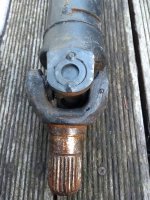Well, that's the leaves roughly gathered , there's always more later though! So I just had a few thoughts about prop shafts in general, just in case you've not all gone to sleep yet!
You'll notice that there is a small piece of curved metal spot welded to the side of the shaft (at the very top of the picture). More "mechanically savvy" forum members will know that this is a balance weight. There is usually one at each end of the shaft, near the U/J's. Their purpose is to take any out of balance forces out of the equation to eliminate vibration. I remember it being a very big problem on Triumph Herald/Vitesse models in particular but I've seen it on others. Balancing at the factory would be done on completed shafts so, right away, you can see the problem when replacing a joint. The overhaul kit you buy is quite likely to have been produced by a different manufacturer and machining tolerances may mean that even on a perfectly installed new joint there may be run out or mass distribution problems. These shafts rotate rapidly, often, in 5th gear, faster than crankshaft revs, so small imperfections generate surprisingly large forces. In addition you may not end up with the cups pressed back into the exact same position in the yokes - not so much of a problem with the circlips type. Also you may "shift" a cup as you are staking it and either end up with a lateral displacement of the joint or a "pinched" joint which is partially siezed (sometimes they slacken off in use though). That's why I said I really quite like the idea of the welded washers - much less chance of displacement. Assembly in a lathe or specialist jig largely gets over the alignment problems but does nothing about mass distribution. However ussualy a shaft assembled in this way will be so little out on balance that you won't notice it unless you swop it for a factory fresh unit when often a small, but noticeable, increase in smoothness and refinement is detected. The problem can manifest itself on badly balanced final drive (axle) shafts on independently suspended cars, but as they typically rotate far slower (maybe 3×) the imbalance has to be considerable to be felt. So we often found ourselves doing the driveshaft joints on Herald/Vitesse but if it was a prop shaft joint at fault the boss would sell a replacement shaft and, although more expensive, it really was the best option for the customer. Don't ask about the Rotoflex couplings on the MK2, or FWD Triumph 1300 - that one was fun to do! - (or Hillman Imp, or Lotus Elan, or??? - did a lot of them, the couplings in general I mean!)
Lastly. I would say to anyone who hasn't had a go at one of these and is thinking about it to get a scrap shaft from a breaker (he'll probably buy it back at reduced value later - mine does, by weight, so the cost is kept minimal) and have a go at removing and then refitting the joint. This is not an easy task if you've never done one before. The cups are full of (never counted them but I would guess maybe 20 to 30) needle roller bearings. I have once seen a design which had the needles caged (maybe Quinton Hazel?) but they are usually loose! You have to position them around the outside of the cup with grease to "stick" them in place and try not to displace them (of course you can't see them during assembly as the journals on the cross piece hide them!) as you manipulate the heavy shaft, the flange (which is the bit with the bolt holes where it's fixed to the diff or, at the other end, the splined sleeve) whilst trying to keep the whole thing lined up in your vice so you can squeeze the cup back into the yoke without any of the needles being displaced! If a needle falls into the bottom of the cup you can fracture the bottom of the cup which scuppers the whole job and you'll have to buy another kit! That one really makes you popular with the boss, I know, been there, done that! Then you've got the good fun of doing it all again 3 more times as the joint has 4 arms! Enjoy, as the youngsters say these days! The first one I did almost had me in tears and the rest of the lads laughing cruelly at my ineptitude! They did stand me to a beer on the way home that night though. I felt I'd passed some sort of mechanics initiation ceremony!
Being now older and wiser and not quite so impecunious as I was in my youth, if an exchange shaft, FROM a REPUTABLE MANUFACTURER or SPECIALIST REBUILDER, (so I could be sure a proper rebalance had been performed), were available at reasonable cost that would always be my preferance. If I had to, as a last resort where no other option were available, I would do it myself but I'd keep in the back of my mind that I just might have to shell out to a specialist engineer for a balance. Oh, and get the children/grandchildren well out of the way, "blue air" is a given!


